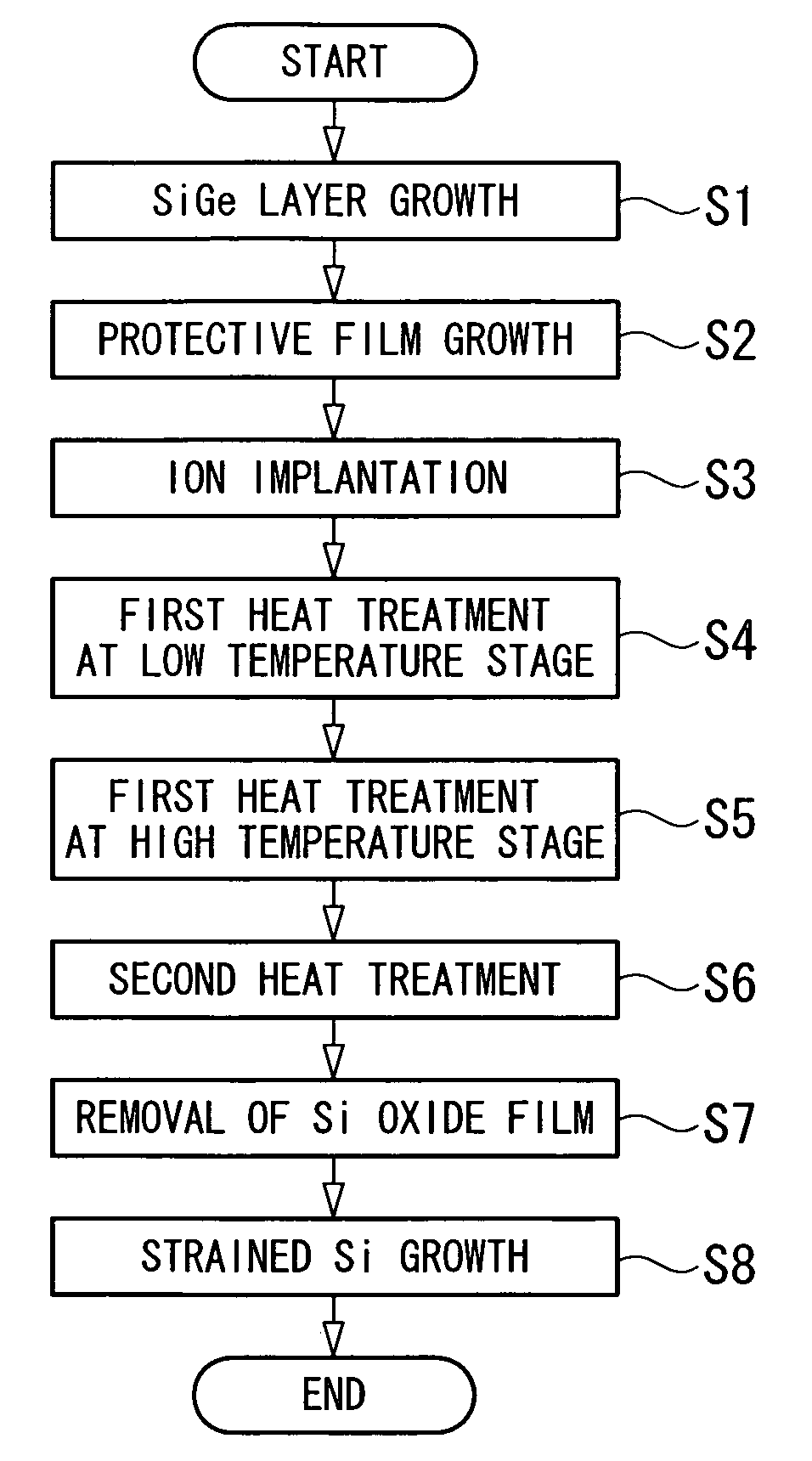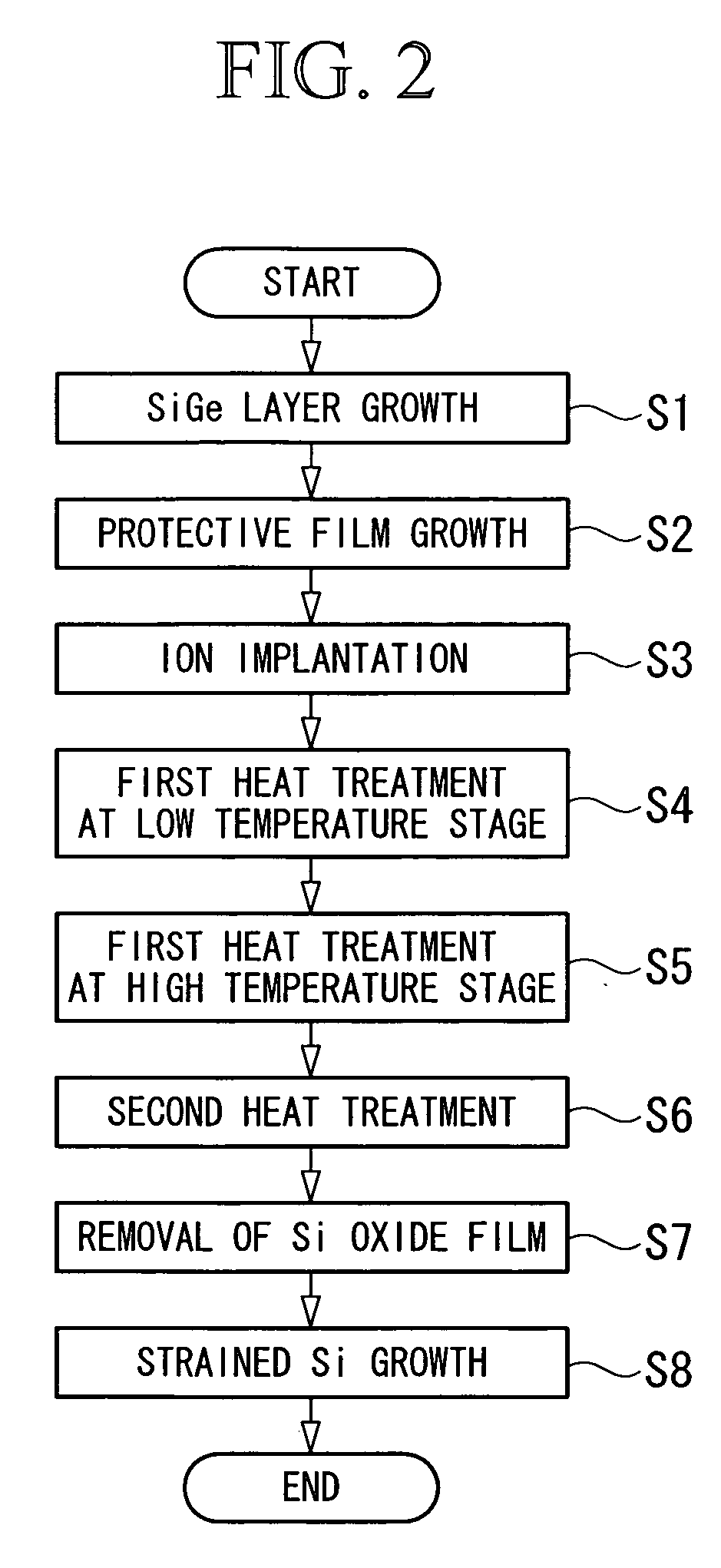Production method of strained silicon-SOI substrate and strained silicon-SOI substrate produced by same
a production method and technology of silicon-soi substrate, which are applied in the direction of basic electric elements, electrical apparatus, semiconductor devices, etc., can solve the problems of insufficient surface roughness, insufficient penetrating dislocation densities and surface roughness of the sige layer, and difficult to retain such a compatible effect within a micro device having a gate length not more than 100 nm, etc., to achieve enhanced strain relaxation of the sige mixed crystal layer, low defect density, and weaken bond strength
- Summary
- Abstract
- Description
- Claims
- Application Information
AI Technical Summary
Benefits of technology
Problems solved by technology
Method used
Image
Examples
first embodiment
[0059] A first embodiment of a production method of a strained Si-SOI substrate of the invention is explained with reference to the drawings.
[0060]FIGS. 1A to 1F are cross sectional views of substrates showing a production process of a strained Si-SOI substrate. FIG. 2 is a process chart showing a production method of a strained Si-SOI substrate in the embodiment. In FIG. 1 the SOI substrate is indicated by numeral 10.
[0061] A strained Si-SOI substrate is produced by the following method.
[0062] Firstly, an SOI substrate 10 is prepared. The SOI substrate 10 comprises an insulator layer (buried oxide layer) 12 on an Si substrate 11, and a single crystalline Si layer (Si layer) 13 on the insulator layer 12. For example, as the SOI substrate 10, it is possible to use an SOI substrate produced by the SIMOX (Separation by IMplanted OXgen) method. In the SIMOX method, by oxygen implantation from a surface of a wafer, a buried oxide layer (a BOX layer) is formed in a portion having a pre...
second embodiment
[0086] Next, a second embodiment of a production method of a strained Si-SOI substrate is explained with reference to the drawings. FIG. 5 is a process chart showing the production method of a strained Si-SOI substrate in accordance with the second embodiment. An explanation for the elements corresponding to the elements of the first embodiment is omitted because the same symbols are used.
[0087] An SOI wafer 10 is prepared to comprise an Si layer 13 of not less than 5 nm in thickness in a buried oxide layer 12.
[0088] The SOI substrate may be produced by a known method such as the SIMOX method, or a bonding method (e.g., Smart-Cutting method, or ELTRAN method).
[0089] As a next step shown in S11 of FIG. 5, the SOI substrate 10 for forming a SiGe layer 14 is subjected to cleaning. The method for cleaning the SOI substrate may be selected from conventional cleaning methods such as SC-1+SC-2 cleaning, cleaning with a mixing solution of HF / O3, and reciprocal cleaning alternately using ...
example 1
1) Example 1
[0108] P-type SOI substrates of 200 mm in diameter were prepared by the SIMOX method. In each wafer, a thickness of a single crystalline Si layer 13 on a buried oxide layer 12 was 50 nm, and a thickness of the buried oxide layer 12 was 140 nm.
[0109] Subsequently, after cleaning of each SOI wafer (SOI substrate) 10 by the SC-1+SC-2 cleaning method, the wafer was immediately introduced to the lamp heater type single wafer type epitaxial growth apparatus.
[0110] Before the epitaxial growth of the SiGe layer, the SOI wafer was subjected to a hydrogen baking treatment. For the baking, the temperature was at 1125° C., atmospheric pressure was 2666 Pa (20 torr), a hydrogen flow rate was 20 SLM (liter per minutes at standard state), and the time was 45 seconds.
[0111] After cleaning of the surface of the substrate 10 by hydrogen baking treatment, a SiGe layer 14 was epitaxially grown. The thickness of the SiGe layer was 100 nm, and its Ge concentration was 10 atomic %.
[0112] F...
PUM
| Property | Measurement | Unit |
|---|---|---|
| thickness | aaaaa | aaaaa |
| temperature | aaaaa | aaaaa |
| temperature | aaaaa | aaaaa |
Abstract
Description
Claims
Application Information
 Login to View More
Login to View More - R&D
- Intellectual Property
- Life Sciences
- Materials
- Tech Scout
- Unparalleled Data Quality
- Higher Quality Content
- 60% Fewer Hallucinations
Browse by: Latest US Patents, China's latest patents, Technical Efficacy Thesaurus, Application Domain, Technology Topic, Popular Technical Reports.
© 2025 PatSnap. All rights reserved.Legal|Privacy policy|Modern Slavery Act Transparency Statement|Sitemap|About US| Contact US: help@patsnap.com



